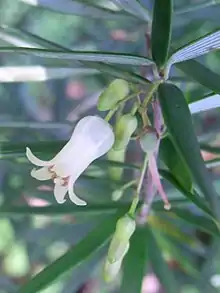Lissanthe sapida
Lissanthe sapida, sometimes referred as the native cranberry is a shrub from the family Ericaceae, found near Sydney, Australia. A rare plant, with a ROTAP rating of 3RCa, it grows in dry eucalyptus woodlands and rocky areas, of soils based on sandstone.[1]
| Lissanthe sapida | |
|---|---|
 | |
| Blue Gum Forest, Australia | |
| Scientific classification | |
| Kingdom: | Plantae |
| Clade: | Tracheophytes |
| Clade: | Angiosperms |
| Clade: | Eudicots |
| Clade: | Asterids |
| Order: | Ericales |
| Family: | Ericaceae |
| Genus: | Lissanthe |
| Species: | L. sapida |
| Binomial name | |
| Lissanthe sapida | |
It usually grows to about 1 m tall, though it may be seen to 2.5 m. Leaves are narrow oblong, around 15 to 25 mm long, 2 to 4 mm wide, with a sharp point. Leaves have seven or eight ribs on the underside. The native cranberry flowers from March to September, with attractive white, bell-shaped, hanging flowers. The juicy fruit is round, red, and hairless with a flat top.
It may be seen in areas such as Bargo, Blackheath, Mountain Lagoon, and the Nepean Gorge.[2]
This plant first appeared in the scientific literature in 1810, in the Prodromus Florae Novae Hollandiae, authored by the prolific Scottish botanist, Robert Brown.
References
- "'Lissanthe sapida, PlantNET - NSW Flora Online". Retrieved 4 June 2011.
- Native Plants of the Sydney District - Alan Fairley & Philip Moore ISBN 0-7318-1031-7, page 91